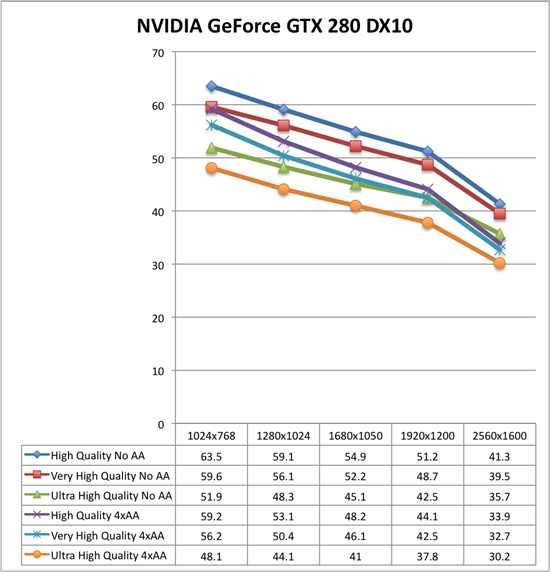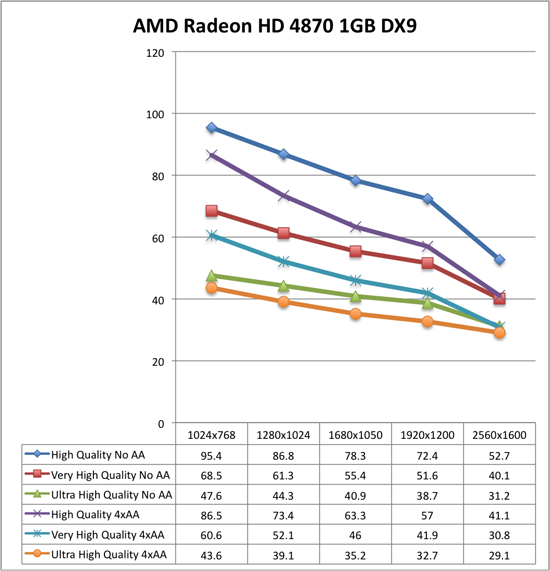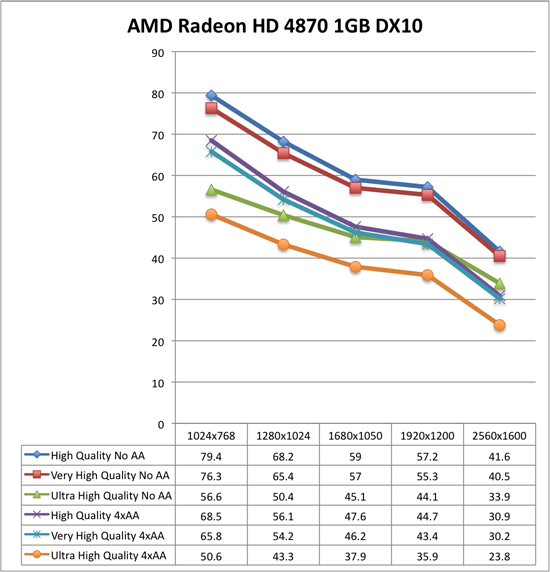Far Cry 2 Dissected: Massive Amounts of Performance Data
by Derek Wilson on November 21, 2008 5:30 AM EST- Posted in
- GPUs
Benchmarking Software: an Analysis of Far Cry 2 Settings under AMD and NVIDIA
Before we get started, let's take a look at our test setup:
Platform: ASUS Rampage II Extreme, Core i7-965, 6GB DDR3-1333, Intel SSD
AMD Driver: Final 8.10 hotfix
NVIDIA Driver: 180.44
Our first goal in getting our testing rolling was to find out what to test and to understand the settings in the game better. We spent time playing the game at different quality levels with different hardware like we generally do. But because we wanted to take advantage of the benchmark tool, we decided to collect a bit of data on different settings with one card from AMD and one card from NVIDIA. We look at three different quality levels under two different DX APIs with two different AA settings across five different resolutions. For those keeping count, that's 60 tests per card or 120 tests total for this section.
The result isn't as much like our usual hardware focused tests, as this provides us with more of an analysis of the game itself. We get a better perspective on how the game responds in different situations with different hardware on different platforms without the need to test every piece of hardware out there. Our hope was that this page could help people who are running a particular setup see generally how performance might change if they tweaked one of the variables. Of course, you can't predict specific performance with this, as there isn't enough data for interpolation purposes, but knowing the general trend and what sort of changes make the largest differences can still be useful.
This test is run with our custom timedemo rather than any of the built in benchmarks.
The cards we chose are the highest end NVIDIA and AMD single GPU solutions (the GeForce GTX 280 and the Radeon HD 4870 1GB). While not everyone will have these cards, we were able to test the broadest range of playable data with them. We'll start our analysis with the NVIDIA hardware in DX9 and DX10.
Now take a deep breath because these graphs can be a little tricky. Each graph is only 6 resolution scaling lines, but you'll want to approach them by looking at two groups of three: blue diamonds, red squares, green triangles are no antialiasing, while purple X, blue *, orange circles are 4xAA.
Under DX9 and NVIDIA hardware, High quality performs significantly higher than Very High quality both with and without AA. Moving from Very High quality to High quality gives at best a 47% increase in performance while the worst case is 27% with 4xAA and 37% without. Performance increases in this case generally trend downward as resolution increases. We also see that High quality 4xAA outperforms Very High quality with no AA. While there is a crossover point, Very High quality with 4xAA also performs very similarly to Ultra High quality with no AA.

Moving to DX10 under NVIDIA hardware, High quality performance takes a dive while the rest of the numbers stay relatively stable. This basic indication here is that DX9 won't gain you much performance (and will sometimes drop your performance a bit) unless you are looking at High quality mode at which case it could be very worth it to run DX9. As a further consequence, the performance benefit of dropping down to High quality in DX10 mode makes it essentailly useless. High quality with 4xAA looses the advantage over Very High quality with no AA. Very High quality or better is the way to go under DX10, and DX9 should only be paired with High quality mode or lower.

The analysis of the AMD data is very similar to what we see with NVIDIA. We see the same big performance advantage of High quality DX9 with DX10 actually increasing performance at the higher quality levels (the exception is at 2560x1600 where performance drops off more sharply than the GTX 280). The major difference here is in the fact that moving from Ultra High quality to Very High quality gives you a much larger performance increase under AMD than NVIDIA. This means that Very High 4xAA has a larger advantage over Ultra High with no AA (except at 2560x1600), and that it is more worth it to drop back to a lower quality setting to gain performance on AMD hardware. We still recommend Ultra High quality though, unless 4xAA is something you just can't live with out (in that case, Very High quality plus 4xAA is probably the way to go).


The comparison we haven't made yet is NVIDIA versus AMD. These tests show that under DX10 AMD Radeon HD 4870 1GB is either higher performing than or performing on par with the NVIDIA GeForce GTX 280 (except at ultra high resolutions with 4xAA). This is very impressive due to the $100 price advantage (the GeForce GTX 280 comes in at 33% more expensive than the Radeon HD 4870 1GB at $400). If you've got a 2560x1600 monitor and want to run Ultra High quality with 4xAA, that's the only case where the GeForce GTX 280 is worth it, though you'll be pushing the playability limit there and SLI with two cheaper cards might be a better way to go.
Going forward, we will be looking at DX10 with Ultra High quality settings and will generally favor testing without AA as we feel that Ultra High quality is a better use of resources than 4xAA. For multi-GPU and high end testing, we will still try to include 4xAA numbers though. This custom timedemo will also be the test we stick with rather than the built in RanchSmall demo.










78 Comments
View All Comments
Ephebus - Monday, November 24, 2008 - link
ATI drivers have always been messy, and not just video card drivers. I was unfortunate enough to purchase a motherboard with an ATI chipset, and installing the latest southbridge and RAID drivers from the Catalyst 8.11 suite (which are available as individual packages for motherboards with ATI chipsets) simply removed the option to uninstall the drivers from XP's control panel and also removed the SATA-AHCI support, so now I have to run my HD's in native IDE mode.ATI drivers are so pathetic that you have to install the SATA-AHCI drivers during OS installation and from DISKETTES (I haven't had a diskette drive for years). Most people above the total-mediocre-user-level resort to some registry patch to install AHCI drivers on an already installed OS (or because they don't have a diskette drive), which worked just fine for me, but the latest release messed that up too.
Worst of all was the response I got from AMD's support, telling me to install the drivers from the motherboard's page (which are nothing but the southbridge drivers from a Catalyst release over 1 year old). Fanboys flame on (I used to be one too, since the K6-2), but this company should recognize their inability to develop drivers for their own products and either let someone else write them or go out of the business.
Slash3 - Tuesday, November 25, 2008 - link
AHCI mode requires all vendors install AHCI drivers at the time of installation for XP. Intel, ATI, AMD or otherwise. Yes, you can slipstream them into an install CD if you're lucky, but XP by default requires the use of the A: diskette drive for controller drivers (needed to enable AHCI or RAID mode). Vista allows the use of USB devices for drivers, and is preconfigured with more out of the gate.Ephebus - Tuesday, November 25, 2008 - link
You forgot NVIDIA. Installers for their chipset drivers are able to install RAID and AHCI drivers on existing XP installations. My previous motherboard was a Foxconn board based on the nForce 560 SLI and I never needed to touch a diskette to get AHCI installed.Ephebus - Tuesday, November 25, 2008 - link
Small correction, it was the nForce 570 SLI based Foxconn N570SM2AA-8EKRS2H. AHCI support was integrated in the nForce installation. Never had a board with an Intel chipset, so I'll have to take your word for it (that AHCI drivers have to be installed from diskette during XP installation as with ATI boards).binarydragons - Monday, November 24, 2008 - link
I couldn't even estimate how long it takes to do these test and with people like me asking for more must get tiring.One configuration I would be intersted in would be SLI mode with one card dedicated to Physics.
I found your article "NVIDIA Fall Driver Update (rel 180) and Other Treats" very intersting.
binarydragons - Monday, November 24, 2008 - link
After posting the PhysX comment I have been doing some reading.I am not sure Nvidia PhysX will make a differnece on Far Cry 2.
From what I can tell Far Cry 2 uses Havok physx which is cpu based.
Genx87 - Monday, November 24, 2008 - link
It would be nice to know the platform's you were using. In the past I had a major stuttering issue with a 6800GT, Nforce 3 chipset drivers, and anything over the 67.xx series drivers. I could either run the 67 series drivers with the Nvidia IDE drivers. Or run the newest version of the graphics drivers with the generic microsoft IDE controller drivers.I am wondering if this is something similar?
Secondly as a new frustrated owner of a 4850. I have since learned to uninstall the control center. What an absolute buggy POS that in my opinion appears to have the sole purpose to cause bsod or other driver related issues.
SiliconDoc - Saturday, November 29, 2008 - link
Exactly, but that CCC isn't a problem either - of course.. just ask anyone - it's perfect, I guess we can only conclude it is not an ATI issue - and that leaves, well we won't say who that leaves... (sarcasm!)( noone replied saying that because in the hype world, your comment does not exist - it's easier to pass right over and pretend it is never there - like you know the other driver issues that "never happen" with ATI. ) (dripping, oozing sarcasm)
I guess if I was an absolute master tech like so many I wouldn't have ATI driver issues... if I could just be like the master geeks I'd be so happy with ATI.
kr7400 - Tuesday, December 2, 2008 - link
Can you please fucking die? Preferably by getting crushed to death in a garbage compactor, by getting your face cut to ribbons with a pocketknife, your head cracked open with a baseball bat, your stomach sliced open and your entrails spilled out, and your eyeballs ripped out of their sockets. *beep* bitch
I would love to kick you hard in the face, breaking it. Then I'd cut your stomach open with a chainsaw, exposing your intestines. Then I'd cut your windpipe in two with a boxcutter. Then I'd tie you to the back of a pickup truck, and drag you, until your useless *beep* corpse was torn to a million *beep* useless, bloody, and gory pieces.
Hopefully you'll get what's coming to you. *beep* bitch
I really hope that you get curb-stomped. It'd be hilarious to see you begging for help, and then someone stomps on the back of your head, leaving you to die in horrible, agonizing pain. *beep*
Shut the *beep* up f aggot, before you get your face bashed in and cut to ribbons, and your throat slit.
You're dead if I ever meet you in real life, f ucker. I'll f ucking kill you.
I would love to f ucking send your f ucking useless ass to the hospital in intensive care, fighting for your worthless life.
http://www.youtube.com/watch?v=Po0j4ONZRGY">http://www.youtube.com/watch?v=Po0j4ONZRGY
I wish you a truly painful, bloody, gory, and agonizing death, *beep*
KnowmaGPUs - Monday, November 24, 2008 - link
Boy, this review site is so biased it's not even funny!
AnandTech definitely puts the 'AT' in 'AT'I...
"None of the AMD cards are stable running FarCry 2, crossfire is dead....but we still recommend 4870...." LOL!!